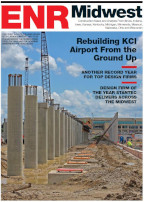New Oil Pipeline From Alberta Would Serve New B.C. Terminal
Enbridge Inc. is itching to get going on its proposed Northern Gateway Pipeline stretching from outside Edmonton, Alberta, to Kitimat, B.C. Initially introduced in 2005, the 727-mile pipeline project is headed to Canada's National Energy Board and the Canadian Environmental Assessment Agency for joint review "very soon," according to Jennifer Varey, spokesperson. If approved, construction could start in 2012.
Calgary, Alberta,-based Enbridge plans to transport 525,000 barrels per day of petroleum in the 36-inch west-moving pipeline and 193,000 barrels per day of condensate—a product used to thin petroleum products for pipeline transport—in the 20-inch east-moving line.
The project, estimated at $4.5 billion in 2005, will be constructed in stages, with the bulk of the work across the two Canadian provinces being available for bid. The plan consists of dividing the work into 12 construction sections to break up the pipeline into manageable sizes for the winter and summer construction periods. Each spread will range in length between 70 and 190 kilometers using steel pipe manufactured to Enbridge's specifications.
Varey says that Enbridge expects to serve as the project and environmental manager on the project and hire multiple contractors to construct the pipeline, as they have done in past projects. Generally, Enbridge uses a variety of contractors on each project.
The pipeline will be buried 3 ft underground over much of the terrain, except for water passages. To receive the petroleum from Alberta's oilsands for shipment to Asia, a new Kitimat Marine Terminal, operated by Enbridge, will be built to include two ship berths and storage tanks.
Public comment on the pipeline will occur after the government agency's initial review of the application. A hearing board has already been set up to review the project that is receiving opposition from groups opposed to both the marine terminal (for fear of oil spills in the ocean) and Native tribes that are against the pipeline crossing their land.
To assuage concerns, Enbridge has done an environmental and socio-economic assessment to identify significant project impacts. An environmental protection and management plan also details Northern Gateway's steps to protect the natural land. Monitoring and follow-up programs, complete with community advisory boards, will begin prior to construction and continue throughout operations to determine�based on effectiveness—if adjustments are needed to improve mitigation.



